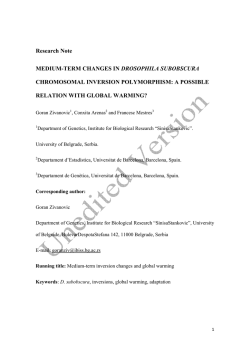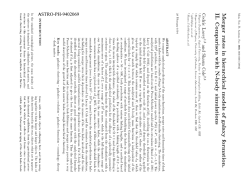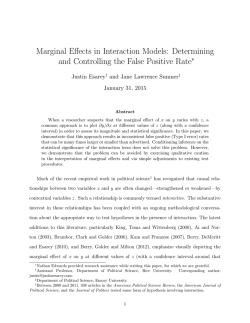
Global warming slowdown: No systematic errors in
Global warming slowdown: No systematic errors in climate models 2 February 2015 analysis. They also clearly showed that the models do not generally overestimate man-made climate change. Global warming is therefore highly likely to reach critical proportions by the end of the century if the global community does not finally get to grips with the problem. Forecasts without systematic errors: climate models, such as the model MPI - ESM LR of the Max Planck Institute for Meteorology, predict a significant increase in temperature by the end of this century, especially at the Earth's poles. No model, however, has predicted the global warming hiatus which climate researchers have observed since the turn of the millennium. This, however, is not due to systematic errors of the models, but to random fluctuations in the climate system. The model predictions are therefore reliable, taking some statistical uncertainty into account. Credit: MPI for Meteorology / Deutsches Klimarechenzentrum (DKRZ) Sceptics who still doubt anthropogenic climate change have now been stripped of one of their lastditch arguments: It is true that there has been a warming hiatus and that the surface of the earth has warmed up much less rapidly since the turn of the millennium than all the relevant climate models had predicted. However, the gap between the calculated and measured warming is not due to systematic errors of the models, as the sceptics had suspected, but because there are always random fluctuations in the Earth's climate. Recently, Jochem Marotzke, Director at the Max Planck Institute for Meteorology in Hamburg, and Piers M. Forster, a professor at the University of Leeds in the UK, have impressively demonstrated this by means of a comprehensive statistical Climate is subject to chance and chaos - which makes life difficult for climate researchers. No wonder that these two unpredictable climate factors lie at the root of a mystery that has baffled scientists since the start of the 21st century. Since then, the temperature of the Earth's surface has increased by only around 0.06 degrees Celsius much less than had been predicted by all 114 model simulations considered in the climate report by the IPCC. Jochem Marotzke and Piers M. Forster have now explained the warming pause in terms of random fluctuations arising from chaotic processes in the climate system. Even more importantly for the two researchers and their colleagues around the world: they did not find any conceptual errors in the models. Most notably, the models do not generally react too sensitively to increases in atmospheric carbon dioxide. "The claim that climate models systematically overestimate global warming caused by rising greenhouse gas concentrations is wrong," says Jochem Marotzke. Climate sceptics often make precisely this claim, citing the warming pause as evidence. Yet they cannot deny that nine of the ten warmest years since systematic climate observations began have occurred in the new millennium and that global warming has slowed at a very high level. The sceptics also ignore the fact that ocean temperatures continue to rise as rapidly as many models have predicted. "On the whole, the simulated trends agreed well with the observations" 1/4 To explain the puzzling discrepancy between model simulations and observations, Jochem Marotzke and Piers M. Forster proceeded in two steps. First, they compared simulated and observed temperature trends over all 15-year periods since the start of the 20th century. For each year between 1900 and 2012 they considered the temperature trend that each of the 114 available models predicted for the subsequent 15 years. They then compared the results with measurements of how the temperature actually rose or fell. By simulating the average global temperature and other climatic variables of the past and comparing the results with observations, climatologists are able to check the reliability of their models. If the simulations prove more or less accurate in this respect, they can also provide useful predictions for the future. This image shows retroactively simulated and observed 15-year trends of the global mean surface temperature since 1900. For each year from 1900 to 1998, the 15-year trend indicates how the temperature will change over the next 15 years. Between 1900 and 1914, it decreased for example, by about 0.09 degrees Celsius. For this first year, the models predict a weaker negative or even positive temperature trend ahead. The colour shading indicates - based on the available 114 simulations - the frequency with which a simulated temperature trend occurs for each start year. The circles represent the observed temperature trends. For 1998, the observed value is at the lower limit of the ensemble of the simulations. This means that between 1998-2012, the temperatures of the Earth's surface increased less significantly on average than predicted by climate models. Credit: Nature 2015/MPI for Meteorology The 114 model calculations withstood the comparison. Particularly as an ensemble, they reflect reality quite well: "On the whole, the simulated trends agree with the observations," says Jochem Marotzke. The most pessimistic and most optimistic predictions of warming in the 15 subsequent years for each given year usually differed by around 0.3 degrees Celsius. However, the majority of the models predicted a temperature rise roughly midway between the two extremes. The observed trends are sometimes at the upper limit, sometimes at the lower limit, and often in the middle, so that, taken together, the simulations appear plausible. "In particular, the observed trends are not skewed in any discernible way compared to the simulations," Marotzke explains. If that were the case, it would suggest a systematic error in the models. No physical reason explains the spread of the predictions In a second step, the two scientists are now analysing why the simulations arrived at disparate results. This analysis can also explain why the various predictions for the past 15 years deviate from the actual observed trend. Random fluctuations and three physical reasons come into question to explain this: The model calculations are based on different amounts of radiant energy from the sun that impinge on the Earth's surface and are stored as a result of the greenhouse effect, e.g. due to atmospheric carbon dioxide. However, their predictions also respond with different degrees of sensitivity to changes in this radiant energy, for example if the carbon dioxide content of the atmosphere doubles. In other words, the models assume different proportions of energy that warm the Earth's surface and the proportion that is sooner or later radiated back into space. Finally, all the climate models assume different amounts of energy stored on the Earth that is transferred to the ocean depths, which act as an enormous heat sink. Using a statistical method, Marotzke and Forster analysed the contributions of the individual factors and found that none of the physical reasons explains the distribution of predictions and the deviation from the measurements. However, random variation did explain these discrepancies very well. In particular, the authors' analysis refutes the claim that the models react too sensitively to 2/4 increases in atmospheric carbon dioxide: "If excessive sensitivity of the models caused the models to calculate too great a temperature trend over the past 15 years, the models that assume a high sensitivity would calculate a greater temperature trend than the others," Piers Forster explains. But that is not the case, despite the fact that some models are based on a degree of sensitivity three times greater than others. The Earth will continue to warm up "The difference in sensitivity explains nothing really," says Jochem Marotzke. "I only believed that after I had very carefully scrutinised the data on which our graphs are based." Until now, even climatologists have assumed that their models simulate different temperature rises because they respond with different degrees of sensitivity to increased amounts of solar energy in the atmosphere. The community of climatologists will greet this finding with relief, but perhaps also with some disappointment. It is now clear that it is not possible to make model predictions more accurate by tweaking them - randomness does not respond to tweaking. Quite apart from their role as scientists, researchers have another reason for greeting the study with mixed feelings: no all-clear signal has been sounded. Climatologists have been fairly correct with their predictions. This means: if we continue as before, the Earth will continue to warm up - with consequences, particularly for developing countries, that we can only begin to fathom. More information: Jochem Marotzke & Piers M. Forster, Forcing, feedback and internal variability in global temperature trends, Nature, 29 January 2015; DOI: 10.1038/nature14117 Provided by Max Planck Society APA citation: Global warming slowdown: No systematic errors in climate models (2015, February 2) retrieved 6 February 2015 from http://phys.org/news/2015-02-global-slowdown-systematic-errors- 3/4 climate.html This document is subject to copyright. Apart from any fair dealing for the purpose of private study or research, no part may be reproduced without the written permission. The content is provided for information purposes only. 4/4 Powered by TCPDF (www.tcpdf.org)
© Copyright 2025
![View announcement [PDF 708.48 kB]](http://s2.esdocs.com/store/data/000465700_1-0b7c69c680e3fa00ddd1676cc9494343-250x500.png)


